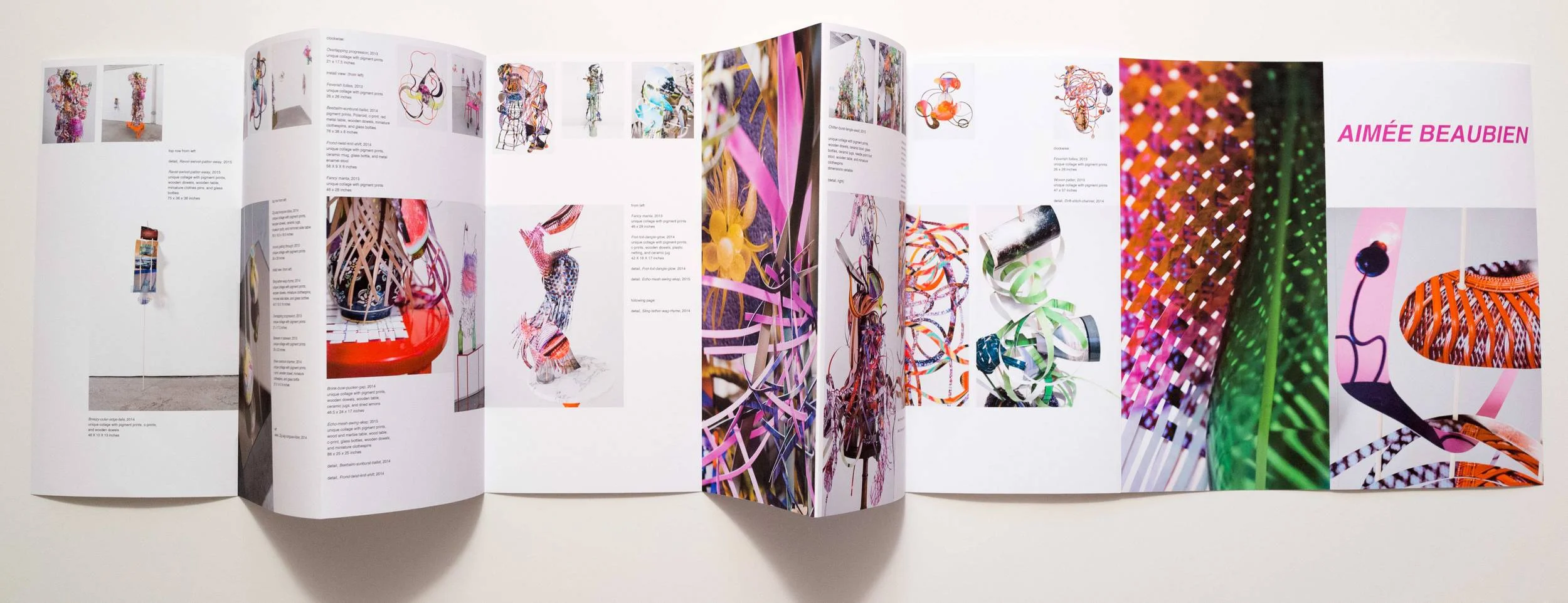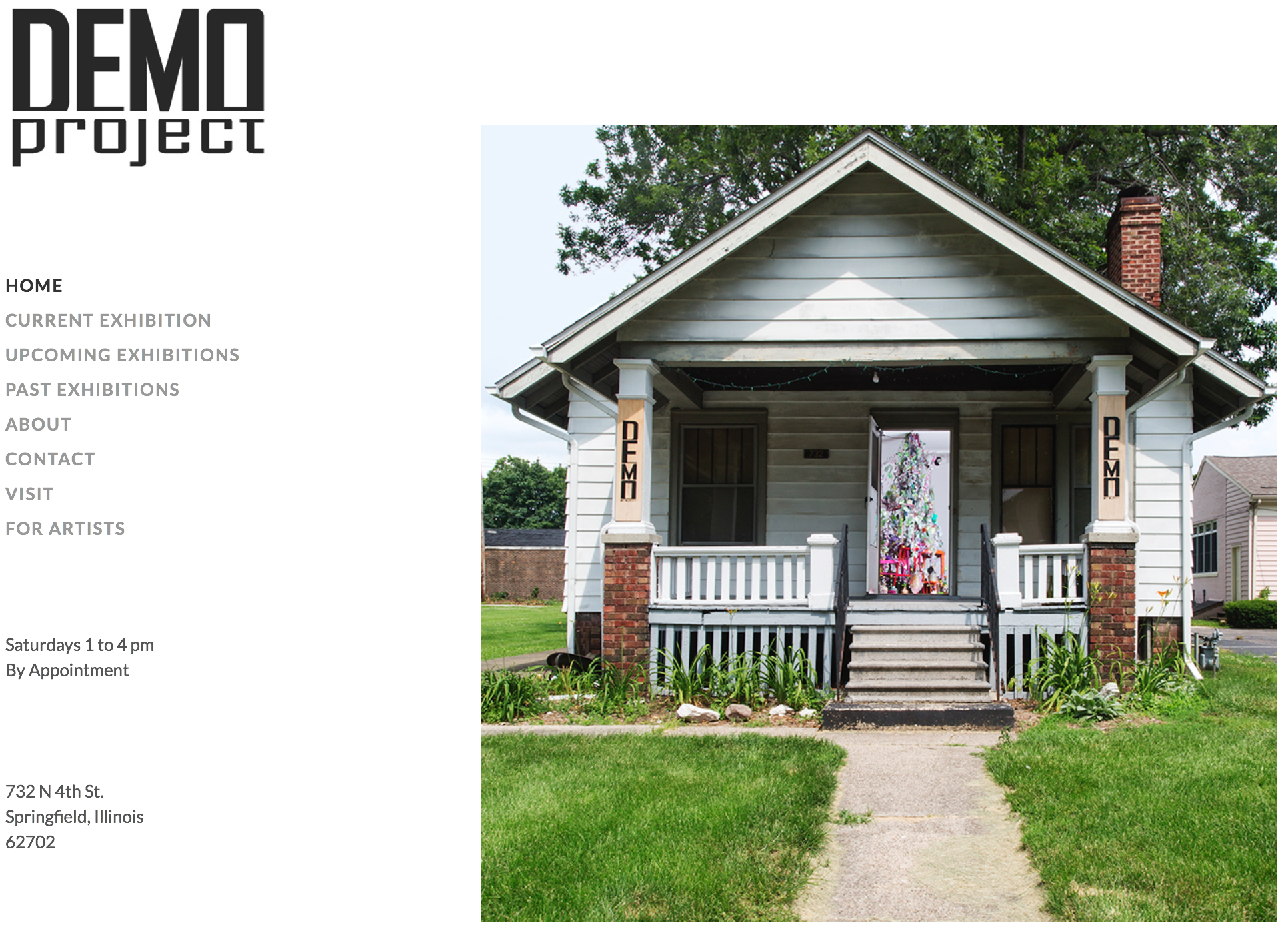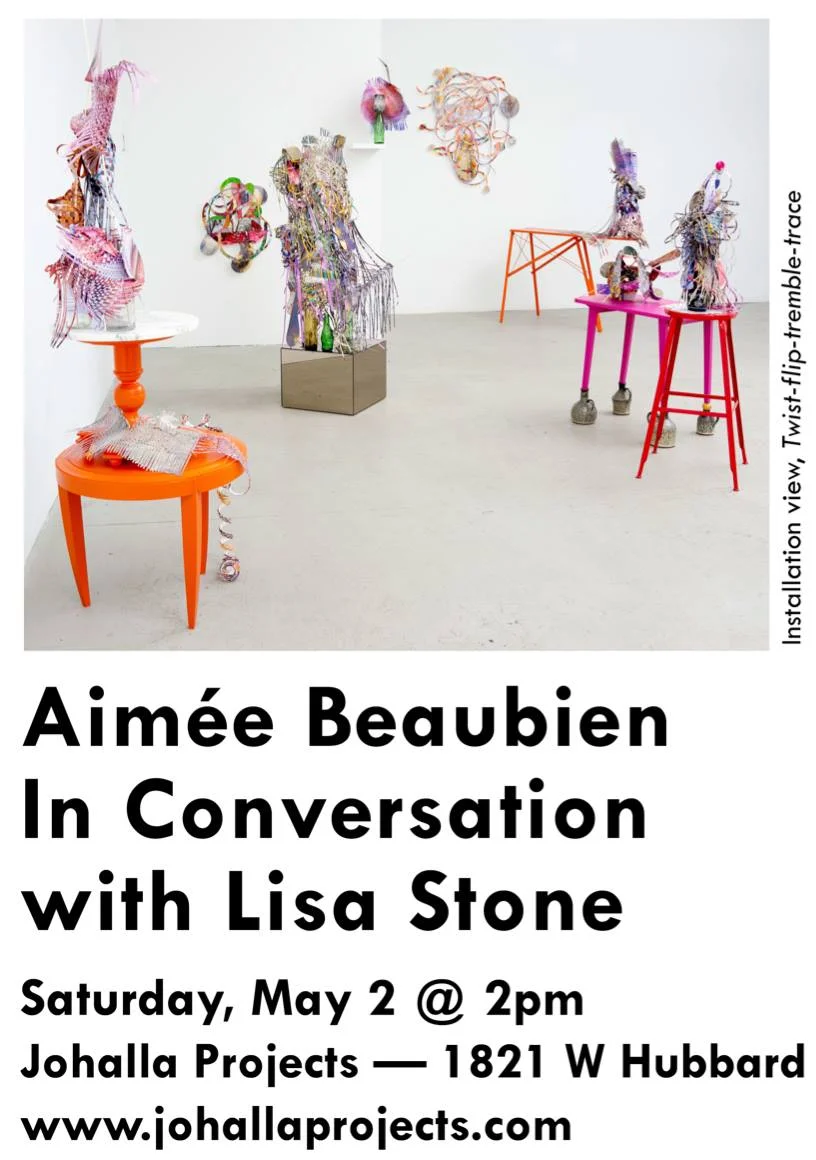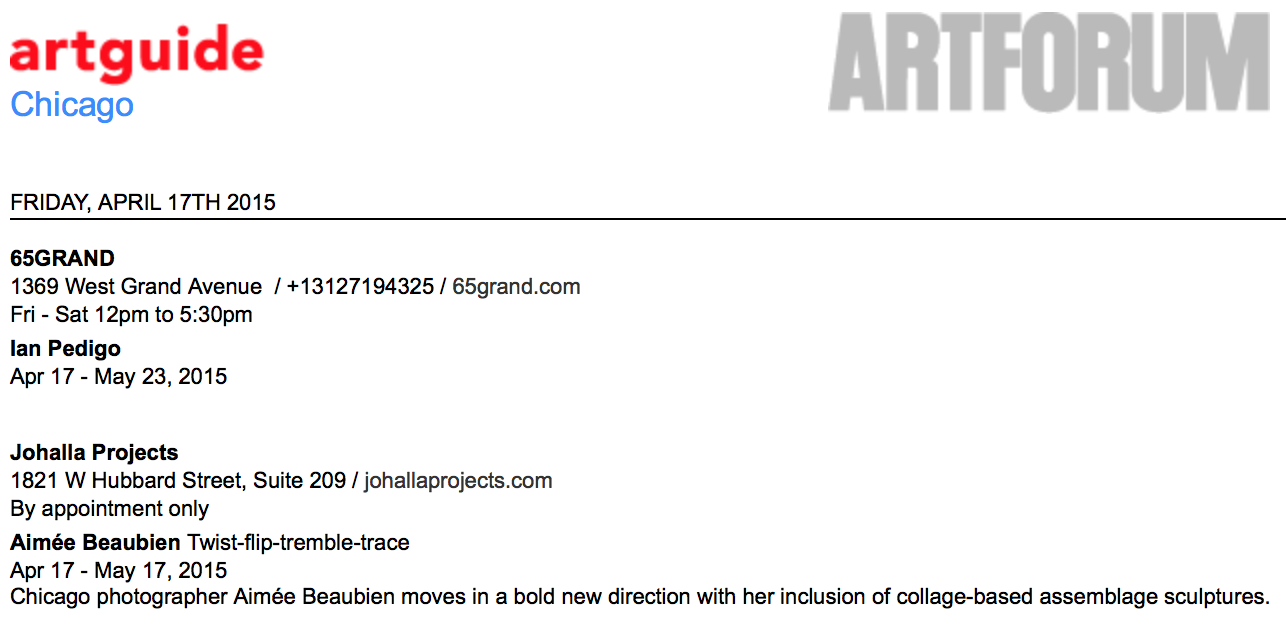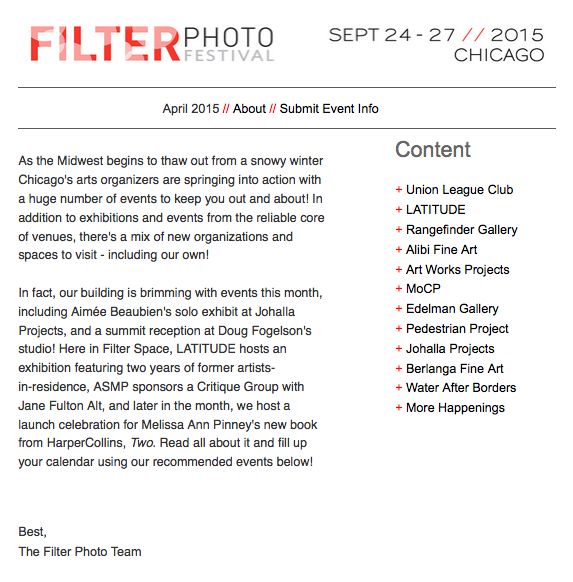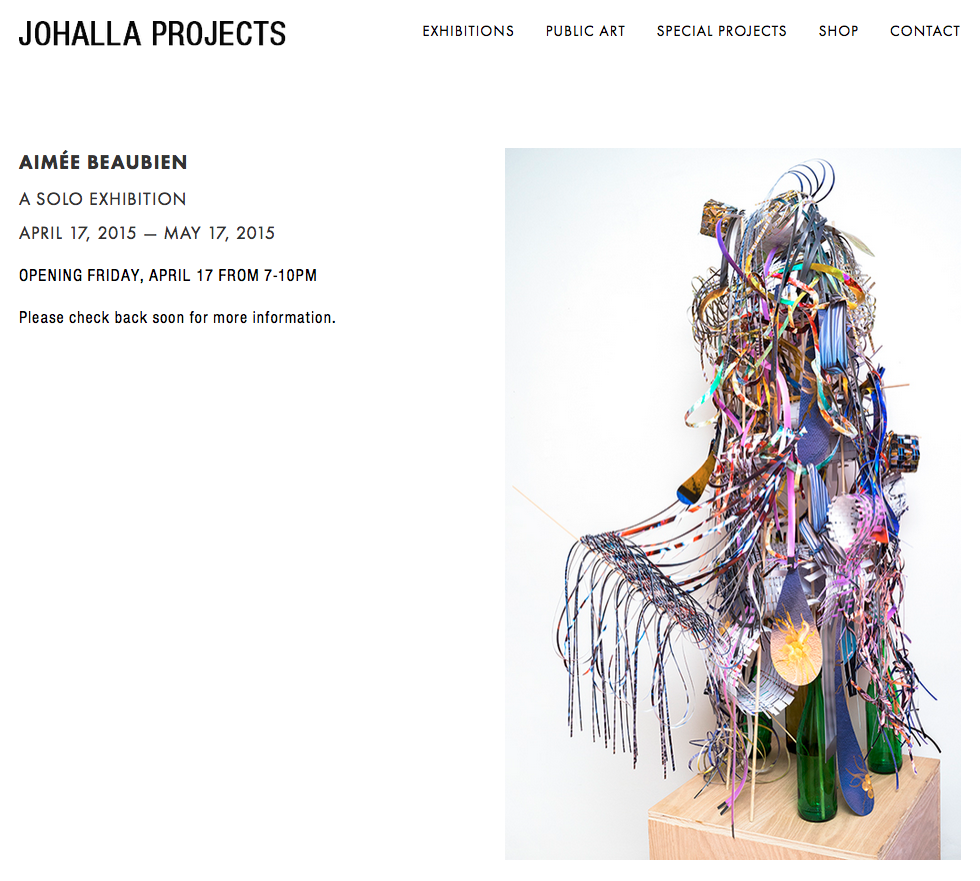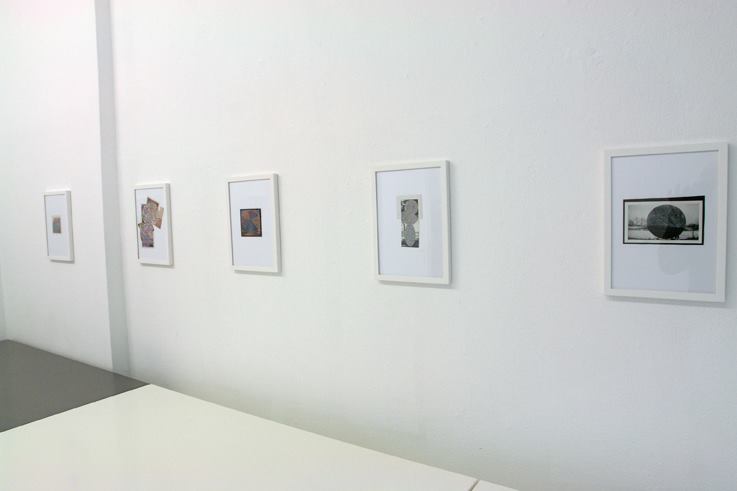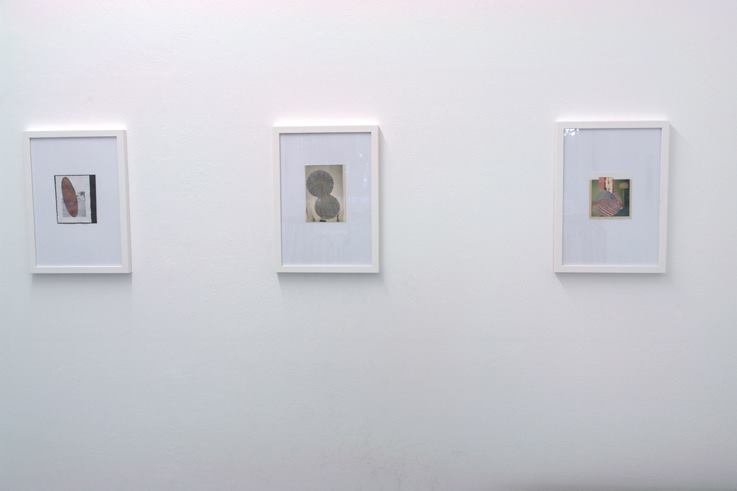Blog
FORM UNBOUND
studio view
Supplement For Midwest Photography Project at MoCP
Untangled first installation at DEMO Project
Winter Thicket at DEMO Project
Winter Thicket at DEMO Project
Leaning, shooting, bedded, staked, staying. Drooping, reclining, pitched, and placed. Sloping, jutting, braced. Holding, heaped. Planted and spread.
Aimee Beaubien’s photographic practice takes shape in inventive forms. Patterns captured from the natural world, museum exhibits, and daily life are printed, cut, and reassembled into wildly colored sculptural works, incorporating and overtaking domestic objects such as vases, jugs, and brightly painted furniture. For DEMO Project, Beaubien constructs a site-specific sculptural installation reaching from floor to ceiling. The visual and temporal entanglements presented by this work provoke a series of experiential shifts between visual representation and physical encounter. Winter Thicket is a vibrant meditation on the intimate intersections between sculptural and photographic practices.
Aimée Beaubien is an artist living and working in Chicago. Her sculptural, photo based collages explore collapses in time, space, and place, while playfully engaging the complexities of visual perception. Solo exhibitions include shows at Johalla Projects, Chicago; TWIN KITTENS, Atlanta, GA; The Cliff Dwellers and Gallery Uno, Chicago; Carl Hammer Gallery, Chicago; Marvelli Gallery, NY. Group exhibitions include Ukranian Institute of Modern Art, Chicago; galerie obqo, Berlin, Germany; UCRC Museum of Photography, Riverside, CA; Art Exhibition Link, Bremen, Germany, and Castello di S. Severa, Italy; Carl Hammer Gallery and Rhona Hoffman Gallery, Chicago. Her work has been reviewed in publications such as Art in America, Art on Paper, and Art Papers. Beaubien is Assistant Professor of Photography at the School of the Art Institute of Chicago.
Winter Thicket opens at DEMO Project on Friday, June 12, from 6:00-8:30pm. The exhibition runs through Sunday, July 4. DEMO is open each Saturday from 1:00-4:00, and is available by appointment (DEMO Project will be closed on July 4 for the holiday, but will schedule appointments that day as needed).
Winter Thicket at DEMO project
Review: Aimée Beaubien/Johalla Projects by Kelly Reaves
There is a video-game term that applies to art making, called “leveling up.” It’s when you make it to the next round, when you discover something game-changing, when you go out on a limb and make such a big step in the right direction that you are suddenly on a higher plane. You leveled up.
Local photographer Aimée Beaubien leveled up with her new body of work, “Twist-flip-tremble-trace.” She took her collages off the wall, weaving strips of photographs together to create the effect of psychedelic cobwebs, held together with dowels and clothespins so that they stand up and command space in the room. These Wonderlandian creatures are precariously perched on cartoonish furniture—an orange painted ironing board, a mirrored pedestal, a low, hot pink table, often incorporating ceramic jugs and glass bottles. Smaller works sit on shelves and hang on the walls, including some new, two-dimensional works, acting as satellites to their larger counterparts. The result is a dizzying installation of optically wiggling, animal-like forms.
The initial and obvious appeal in these works is in their forms—powerfully beautiful with a delicacy that appears constantly on the verge of collapse. Beaubien starts by collecting “raw material”—photographing her world of nature and science and art. By cutting the photos up, she obscures the sources, leaving them only occasionally and partially intact. Close inspection reveals self-reference, in that she often uses photos of her own sculptures in her sculptures. They are made of cut up and woven photos of cut up and woven photos of cut up and woven photos. The infiniteness of it is mind-boggling, giving the effect of a hall of mirrors.
“Twist-flip-tremble-trace” reads as a carnival of perception, an exuberant leap into the future of media hybridization. With these opulent and optically perplexing arrangements, Beaubien antagonizes our brain’s yearning to make sense of spatial arrangements, and it feels like a fun game that we could happily play forever and never win. (Kelly Reaves)
Through May 31 at Johalla Projects, 1821 West Hubbard - See more at: http://art.newcity.com/2015/05/09/review-aimee-beaubienjohalla-projects/#sthash.dOfdNftR.dpuf
Artist and Correspondent Hyounsang Yoo asked great questions about art & teaching for fARTS Magazine -- What is Creative Fodder?
FARTS is a platform for emerging artists in pursuit of their ambitions in fashion, art, and subculture. By inviting each artist to share his or her personal lifestyle, we are exploring their artistic journey – and vice versa. We envision a day when everyone can understand and accept others' perspectives and lifestyles as “different” rather than “wrong”. Until then, we will continue to cheer them on to be loud.
Can you introduce yourself and tell a little bit about your background?
Growing up I was always the new kid. It would sometimes be frustrating to explain our constant moves. In response, my dad suggested telling people he was connected to the Mafia, while my mom would harp on the great potential to reinvent ourselves.
I have since met many artists from similarly highly mobile backgrounds. Now I have been living in the same the house for six years in Logan Square and teaching in the Department of Photography at the School of the Art Institute of Chicago since 1997.
Can you elaborate on your work for us?
My work is created by physically cutting up my photographs and putting them back together in invented forms, playfully engaging the complexities of visual and visceral perception.
I have always been curious about the fragmentary nature of our lived experiences. In some part slipping in and out of so many different schools may have tuned my frequency towards observing states of flux. And as far back as I can remember I cut things up, instinctively beginning as a process of investigation. In high school I started using my camera as my primary tool to excise material from the observable world.
Now, the photographs I take continue to transform: cut fragments of my photographs are joined into sculptural constructions. In putting things together and tearing things apart, I practice performances of revision and re-imagining.
What are you trying to show by using collage?
Collage is destruction and construction, a simultaneous collapsing of time, space and place.
Photography images the world as beguiling fragments. I use photography as a way to channel different spaces of engagement into new proximities. I love to conjoin wildly different photographic experiences into a single piece. The interwoven forms that result from my interventions upend photographic expectations of foreground, background, object, subject and motion.
The physicality of my photo based constructions draws attention to visible seams that function as visual reminders of the various ways the constructed world is offered to us in pictures.
What influences on your art practice lead you to using unique collage methodology?
My earliest recollection of a collaged body was observed on my great-grandmother's refrigerator door. Gertrude Bastien's (1896-1982) eighty year old face had been cut out of a snapshot and taped to the body of a plus size model cut from an advertising environment and dressed only in control top panty hose. Her charged self-image effectively designed to control her appetite has continued to entertain my engagement with restructuring photographic bodies.
As I studied the rich history of collage, montage and cutups my commitment to investigating how far I could push photographic material around intensified. In the act of seeing we string images together. Sampling, mixing and remixing are woven throughout our daily experiences. I grew up heavily influenced by the Pictures Generation. Their use of photography opened my eyes to the fluidity of images. I am thrilled to discover so many different ways artists use photography.
We want to know more about your image collection process.
For me a still image is never really as static and frozen as it may appear.
Relying on our acceptance of a photograph as a record of a specific moment, I capture raw material by photographing what I encounter. This may include elements of the natural world, the biological world, or the constructed worlds of art exhibitions, craft objects, and urban environments.
In my practice, the documentary capacity of photography is used as a notational form: citing colors, patterns, spaces, and the specificities of time and place. And then in the process of working with my printed photographs, they shift from pictures of things to objects I create comprised of pictures.
Where do you usually go to collect images for your works?
I go through active image collection phases, taking my camera everywhere.
I veer away from presenting one single, static position and away from one fixed point of view. I favor conjuring forms that are a synthesis of multiple realities existing simultaneously. Practically speaking I look up, down, or closer and even closer: finding patterns in the things I photograph.
As a professor at school and an artist, is your artwork influenced by teaching.
I am influenced by the environments I move through in profound ways, as most people are. Often the specificity of that influence can be difficult to precisely account for in the moment.
The classroom is a dynamic space facilitating experimentation and under these conditions we actively engage in learning from each other. Being in a collaborative educational environment balances the hours of working alone in your studio.
I assume there are different types of students in school. Do you have an example of a challenging experience including how to communicate with students in that circumstance?
Human behavior and group dynamics are fascinating. Having taught for 18 years the challenges continue to evolve. Teaching before the information superhighway (aka the Internet) was a completely different beast. I like to think of the classroom as a work in process. In each semester and even each class I am presented with an opportunity to make adjustments and try something new.
What type of student are you?
I have a way of charting the most difficult path first. If I can make it more complicated I generally do, and you can see this reflected in the things that I make. Since I am naturally curious about other artist’s working process I studiously chase opportunities to learn more from lectures, documentaries, books and directly from fellow artists.
Do you have goals in life outside of being an artist?
Life is being an artist. Being an artist is something that never really powers off. While teaching I am actively drawing on my experiences as an artist.
Artists become fearless innovators in contemporary art by approaching interdisciplinarity with fluidity. This happens in the field of photography. What are your observations and experiences with interdisciplinarity nature of contemporary art practices?
History helps us navigate the present. I like bad reality television as much as I enjoy seeing people get whipped up about the state of contemporary art. Who can resist being seduced by perpetual declarations from painting is dead to detailed examinations of the anxieties of photography? The exciting way to engage with seemingly conflicting information is to consider everything as creative fodder.
What is your ultimate goal and direction?
Remain connected to the things that I make and in conversation with others.
If you were to represent yourself as a color, what color would you be and why did you choose the color?
Yellow. Yellow seems strong, yet hard to pin down, and sensitive to everything in it’s vicinity.
Lisa Stone & Aimée Beaubien in conversation at Johalla Projects
A bold new direction
Johalla Projects opening Friday, April 17th, 7 - 10pm
Just days away... thank you for the shout-out Filter!
Twist-flip-tremble-trace
studio view
Closing Nov. 30th - Stella: The Nature of a Collective
Opening at Comfort Station
GRAFT: A collaborative project and exhibition featuring new work by Noelle Allen
Exhibition Dates: Nov. 8 to Nov. 30, 2014
Reception: Nov. 8th from 4-8pm
Comfort Station is proud to announce the latest exhibition of Noelle Allen's work for GRAFT, this November. Conceived as a group show within a solo show, Graft is a curatorial experiment that will also feature work from contributing artists that are influential to, or inspired by, Allen’s artistic practice.
For GRAFT, artist Noelle Allen, together with Chicago curator MK Meador, will explore the concept of grafting and how it relates to a multifaceted art contemporary practice. As a horticultural process, grafting involves taking a sample from one plant to fuse and propagate another. For GRAFT, Allen has assembled and reconceptualized older drawings and photograms that date from earlier in her artistic career before having children and a fulltime teaching commitment. Viewing these moments as pivotal turning points in her practice, Allen’s newly realized drawings are, in one sense, grafts from her own work. By fusing old work with new, Allen is physically and conceptually bridging two very different time periods. With imagery and ideas in her work making reference to flowers, root structures, rhizomes, and other organic materials grafting is a concept that warranted further exploration...
Looking at Allen’s work as artist, educator, mentor and mother, Meador and Allen conceived of a show as a curatorial experiment that would invite artists to participate and further explore the notion of grafting. These selected artists will respond to her most recent drawings by contributing a piece of their own for the exhibit at Comfort Station. By grafting the work from these notable Chicago artists, the exhibition will challenge the dichotomy of solo show versus group show models. The GRAFT project will include and document multiple stages of the collaboration between the artists, eventually resulting in a catalogue with interviews, images, and text. The list of confirmed artists include luminaries in the Chicago arts scene including: Claire Ashley, Karen Azarnia, Aimee Beaubien, Erin Minckley Chlagmo, Anne Harris, Allison Reimus, Melody Saraniti, Tess Farris and also features work from Allen’s mother, Californiabased
artist Christine Remy.
The exhibition is curated by MK Meador for Comfort Station.
Elin Spring reviews The Nature of a Collective
paperfile pop up | Aimée Beaubien 11. Oktober 2014 — 15. November 2014
Galerie oqbo
paperfile pop up | Aimée Beaubien
11. Oktober 2014 — 15. November 2014
Mit paperfile pop up startet oqbo ein neues Ausstellungsformat. Begleitend zu jeder Ausstellung wird eine Künstlerin oder ein Künstler mit ausgewählten Arbeiten aus dem paperfile Archiv vorgestellt.
Den Anfang macht die in Chicago lebende Künstlerin Aimée Beaubien.
paperfile pop up is our new exhibition format at oqbo! You can see one of our paperfile artists in every upcoming show!
Aimée Beaubien from Chicago will start in the exhibition of Frank Eltner!



